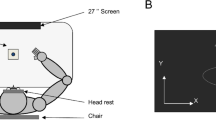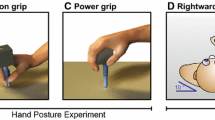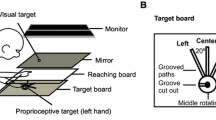Abstract
We have previously shown that the pattern of interlimb transfer following visuomotor adaptation depends on whether the two arms share task-space at a given workspace location: when the two arms adapted to a novel visuomotor rotation in unshared, lateral workspaces, transfer of movement direction information occurred symmetrically (i.e., from dominant to nondominant arm, and vice versa). When the two arms shared the same task-space, however, transfer of the same information became asymmetric (i.e., only from dominant to nondominant arm). In the present study, I investigated the effect of a conflict between visual and proprioceptive information of task-space on the pattern of interlimb transfer, by dissociating visual and motor workspaces. I hypothesized that the pattern of interlimb transfer would be determined by the way the motor control system uses available sensory information, and predicted that depending on whether the system relied more on vision or proprioception, transfer would occur either symmetrically or asymmetrically. Surprisingly, the results indicated that despite substantial adaptation to a novel visuomotor rotation, no transfer occurred across the arms when the visual and motor workspaces were dissociated in space. Based on this finding, I suggest that when a conflict exists between visual and proprioceptive information with respect to the sharing of the given task-space by the two arms, it interferes with executive decisions made by the motor control system in determining hand dominance at a given workspace, which results in a lack of transfer across the arms.


Similar content being viewed by others
References
Bagesteiro LB, Sainburg RL (2002) Handedness: dominant arm advantages in control of limb dynamics. J Neurophysiol 88:2408–2421
Bagesteiro LB, Sainburg RL (2003) Nondominant arm advantages in load compensation during rapid elbow joint movements. J Neurophysiol 90:1503–1513
Bernier PM, Gauthier GM, Blouin J (2007a) Evidence for distinc, differentially adaptable sensorimotor transformations for reaches to visual and proprioceptive targets. J Neurophysiol 98:1815–1819
Bernier PM, Chua R, Inglis JT, Franks IM (2007b) Sensorimotor adaptatioin in response to proprioceptive bias. Exp Brain Res 177:147–156
Boy F, Palluel-Germain R, Orliaguet JP, Coello Y (2005) Dissociation between “where” and “how” judgments of one’s own motor performance in a video-controlled reaching task. Neurosci Lett 386:52–57
Bryden PJ, Roy EA (2006) Preferential reaching across regions of hemispace in adults and children. Dev Psychobiol 48:121–132
Cisek P (2007) Cortical mechanisms of action selection: the affordance competition hypothesis. Philos Trans R Soc Lond B 362:1585–1599
Fitts PM (1954) The information capacity of the human motor system in controlling the amplitude of movement. J Exp Psychol 47:381–391
Gabbard C, Helbig CR (2004) What drives children’s limb selection for reaching in hemispace? Exp Brain Res 156:325–332
Gabbard C, Rabb C (2000) What determines choice of limb for unimanual reaching movements? J Gen Psychol 127:178–184
Galea JM, Miall RC, Woolley DG (2007) Asymmetric interlimb transfer of concurrent adaptation to opposing dynamic forces. Exp Brain Res 182:267–273
Goodbody SJ, Wolpert DM (1999) The effect of visuomotor displacements on arm movement paths. Exp Brain Res 127:213–223
Hwang EJ, Smith MA, Shadmehr R (2006) Dissociable effects of the implicit and explicit memory systems on learning control of reaching. Exp Brain Res 173:425–437
Krakauer JW, Ghilardi MF, Ghez C (1999) Independent learning of internal models for kinematic and dynamic control of reaching. Nat Neurosci 2:1026–1031
Mon-Williams M, Wann JP, Jenkinson M, Rushton K (1997) Synaesthesia in the normal limb. Proc R Soc Lond B Biol Sci 264:1007–1010
Oldfield RC (1971) The assessment and analysis of handedness: the Edinburgh Inventory. Neuropsychologia 9:97–113
Pipereit K, Bock O, Vercher JL (2006) The contribution of proprioceptive feedback to sensorimotor adaptation. Exp Brain Res 174:45–52
Prescott TJ, Redgrave P, Gurney K (1999) Layered control architectures in robots and vertebrates. Adapt Behav 7:99–127
Reddi BAJ, Asrress KN, Carpenter RHS (2003) Accuracy, information, and response time in a saccadic decision task. J Neurophysiol 90:3538–3546
Redding GM, Wallace B (1996) Adaptive spatial alignment and strategic perceptual-motor control. J Exp Psychol HPP 22:379–394
Roby-Brami A, Burnod Y (1995) Learning a new visuomotor transformation: error correction and generalization. Brain Res Cogn Brain Res 2:229–242
Roe RM, Busemeyer JR, Townsend JT (2001) Multialternative decision field theory: a dynamic connectionist model of decision making. Psychol Rev 108:370–392
Rossetti Y, Desmurget M, Prablanc C (1995) Vectorial coding of movement: vision, proprioception, or both? J Neurophysiol 74:457–463
Sainburg RL (2002) Evidence for a dynamic-dominance hypothesis of handedness. Exp Brain Res 142:241–258
Sainburg RL, Kalakanis D (2000) Differences in control of limb dynamics during dominant and nondominant arm reaching. J Neurophysiol 83:2661–2675
Sainburg RL, Wang J (2002) Interlimb transfer of visuomotor rotations: independence of direction and final position information. Exp Brain Res 145:437–447
Sainburg RL, Lateiner JE, Latash ML, Bagesteiro LB (2003) Effects of altering initial position on movement direction and extent. J Neurophysiol 89:401–415
Sarlegna FR, Sainburg RL (2006) The effect of target modality on visual and proprioceptive contributions to the control of movement distance. Exp Brain Res 176:267–280
Uno Y, Kawato M, Suzuki R (1989) Formation and control of optimal trajectory in human multijoint arm movement. Minimum torque-change model. Biol Cybern 61:89–101
Usher M, McClelland JL (2001) The time course of perceptual choice: the leaky, competing accumulator model. Psychol Rev 108:550–592
van Beers RJ, Wolpert DM, Haggard P (1999) Integration of proprioceptive and visual position-information: an experimentally supported model. J Neurophysiol 81:1355–1364
van Beers RJ, Wolpert DM, Haggard P (2002) When feeling is more important than seeing in sensorimotor adaptation. Curr Biol 14:834–837
Wang J, Sainburg RL (2003) Mechanisms underlying interlimb transfer of visuomotor rotations. Exp Brain Res 149:520–526
Wang J, Sainburg RL (2004) Limitations in interlimb transfer of visuomotor rotations. Exp Brain Res 155:1–8
Wang J, Sainburg RL (2005) Adaptation to visuomotor rotations remaps movement vectors, not final positions. J Neurosci 25:4024–4030
Wang J, Sainburg RL (2006a) Interlimb transfer of visuomotor rotations depends on handedness. Exp Brain Res 175:223–230
Wang J, Sainburg RL (2006b) The symmetry of interlimb transfer depends on workspace locations. Exp Brain Res 170:464–471
Wang J, Sainburg RL (2007a) Interlimb competition for task control. Soc Neurosci (Abstract 4136)
Wang J, Sainburg RL (2007b) The dominant and nondominant arms are specialized for stabilizing different features of task performance. Exp Brain Res 178:565–570
Woolley DG, Tresilian JR, Carson RG, Riek S (2007) Dual adaptation to two opposing visuomotor rotations when each is associated with different regions of workspace. Exp Brain Res 179:155–165
Zhang W, Rosenbaum DA (2007) Planning for manual positioning: the end-state comfort effect for manual abduction-adduction. Exp Brain Res (Epub ahead of print)
Acknowledgments
This research was supported by National Institutes of Health grant K01HD050245.
Author information
Authors and Affiliations
Corresponding author
Rights and permissions
About this article
Cite this article
Wang, J. A dissociation between visual and motor workspace inhibits generalization of visuomotor adaptation across the limbs. Exp Brain Res 187, 483–490 (2008). https://doi.org/10.1007/s00221-008-1393-x
Received:
Accepted:
Published:
Issue Date:
DOI: https://doi.org/10.1007/s00221-008-1393-x




